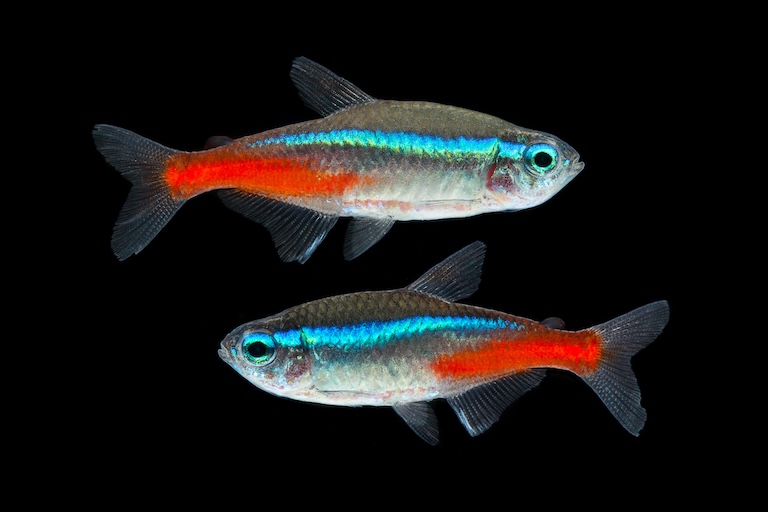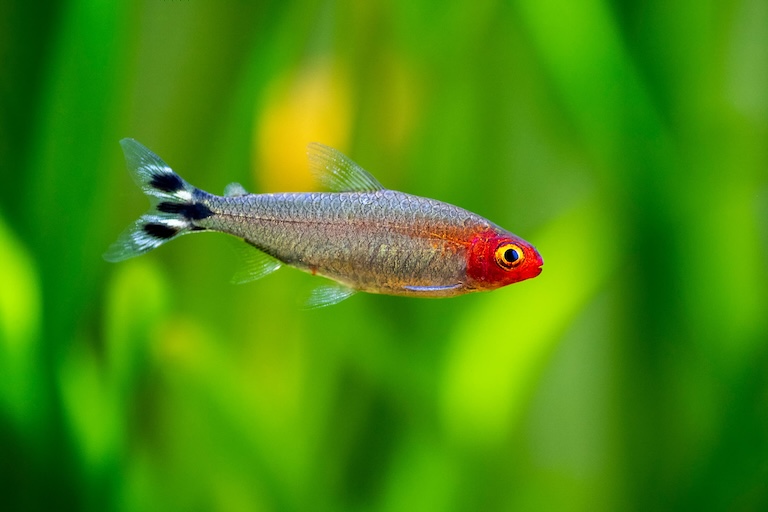Tetra Profile
In the old days, things were much better.
These were simpler times, with segregated bathrooms, polio, steam-powered tractors and hamburgers made out of meat. Men were men, women were women, and tetras were grouped into a single family: the Characidae.
Then, along came the woke agenda and messed everything up. Now, milk comes from plants, women can vote, and prior groups of tetras have been identified as totally unrelated and placed into their own families.
It doesn’t matter that it’s much more appropriate and a vast improvement on our previous understanding of the way things work – it’s different and therefore we don’t like it.

Tetra Facts Overview
| Habitat: | Freshwater |
| Location: | Tropical Africa, Central and South America |
| Lifespan: | Some species live more than 15 years in captivity |
| Size: | Usually very small, less than 5cm (2 in), largest up to 2 metres |
| Weight: | Usually less than a gram, largest up to 70 kg (154 lb) |
| Colour: | Varied, most popular are brightly coloured, striped and/or translucent |
| Diet: | Mostly carnivorous, small arthropods, worms |
| Predators: | Larger fish, birds, and crustaceans |
| Top Speed: | Unknown |
| No. of Species: | Likely 1000+ |
| Conservation Status: | Most unlisted or of Least Concern. Some are Vulnerable to Critically Endangered. |
Tetras are no longer considered in taxonomic or phylogenetic terms, since it was discovered that they are all from different lineages. Instead, they are a catch-all term for casual freshwater aquarists, and more serious observers need to rely on their scientific names instead. But they’re all grouped in a single order of freshwater fish, and within this order, there is tremendous diversity. From the dazzling little neon tetra to one of the most feared freshwater fish known, tetras are the most widely kept fish species in the world.
Interesting Tetra Facts
1. They’re ‘polyphyletic’
Tetras were once thought to comprise a single family of freshwater fish. This family, the Characidae, is still around, only those pesky geneticists have fractured it substantially and removed a whole bunch of species from it. The Characids come from Central and South America, and before scientists figured it out, this family contained what is now 17 or so other families of fish.
Today, seven of these families, including the Characids, are considered tetras, but they’re no longer considered a taxonomic group, being, as they are, totally unrelated species.
In fact, considering the group polyphyletic itself is sort of inaccurate, as this grouping of so-called Tetras is no longer considered a taxonomic or phylogenetic term. 1

2. They’re Characiformes
All accepted families of tetras do still fit into a single order of bony fish, so they’re not entirely unrelated. In fact, the order Characiformes contained just the one family, Characidae, until it was broken up.
The Characiformes are now an order of 18 families of fish with over 2,000 species – not all of them tetras, and it’s the same order as the infamous piranhas, and tetras, while carnivorous, are generally less bitey. Still, as we’re about to discuss, their diversity necessitates some exceptions, even to this! 2
3. Four fins
What initially grouped all these species together was the presence of a small, fleshy fin behind the dorsal fin, giving them a fourth unpaired fin on their bodies, and therefore “Tetra”, being Greek for “four”, makes sense.
Why these seemingly unrelated fish all have this trait isn’t clear, but there are also exceptions at the species level, which don’t have one at all.
4. Adonis Tetra
Some of these new families are very limited in composition. The Lepidarchidae family contains just a single genus with just two species in it, one of which is the so-called jellybean or Adonis tetra.
This, along with a tremendous range of other species under the Tetra umbrella, is a popular fish in freshwater aquaria.
Tetras are best known as hardy, colourful and charismatic fish that function well in groups inside fish tanks at home. They may well be quite unrelated, but they do share some commonalities in this way.
Still, when there are exceptions, they can be truly exceptional.
5. Goliath Tigerfish
Not all Tetras are small and pretty. The family Alesdtidae, commonly known as the “African Tetras”, contains a proper behemoth known as the Goliath Tigerfish.
This is the largest species in the family, and reaches up to 70kg and 2 metres in length. It also sports an ominous mouth full of long, sharp teeth.
This is by no means a pretty little home aquarium fish, but at the other end of the spectrum are the pretty little versions like the neon tetra. 3

6. Neon Tetras
Neon tetras are about as diametrically opposed to goliath tigerfish as you can find.
These are stunningly coloured, tiny, and peaceful animals, and one of the most recognisable in any home tropical aquarium. They’re originally from Colombia, but more commonly known from the ten to twenty-gallon tanks hobbyists keep them in, and sport a metallic blue stripe above a red streak.
This species is in the OG tetra family, the Characidae, and is one of the most widely-kept species of fish, let alone tetra, in the world.
Unfortunately, not all tetras are as well cared for. 4
7. Some are endangered
IUCN’s Red List is a fantastic repository for the conservation statuses of various species. But sometimes, it’s also an illumination of the painfully finite resources (financially and emotionally) we put into conservation as a whole.
The species Phenacogaster simulata is listed on the Red List, under the common name “Tetra”, and assessed to be Critically Endangered and in decline. Its most recent assessment was in 2020, which, for such a desperate species, is becoming quite out of date, and the spattering of detail around it reflects how much of an afterthought its protection must have been.
Here is a tetra so close to forgotten it barely has a common name, let alone a Wikipedia page, and it’s already critically endangered. Yet, this is one of the lucky few species to actually be described in the literature before it disappears forever. 5
On a lighter note, though, the vast majority of known tetra species are doing far better – even within this single genus, all that are listed are assessed to be of Least Concern and Stable.
Tetra Fact-File Summary
Scientific Classification
| Kingdom: | Animalia |
| Phylum: | Chordata |
| Class: | Actinopterygii |
| Order: | Characiformes |
| Family: | 18 families |
Fact Sources & References
- Juan Marcos Mirande (2019), “Morphology, molecules and the phylogeny of Characidae (Teleostei, Characiformes)”, Wiley Online Library.
- , “Characiformes”, Science Direct.
- Ghaui et. al (2020), “Goliath tigerfish”, FieldSports Journal.
- Shirlie Sharpe(2025), “The Vibrant Neon Tetra: A Complete Species Profile for Enthusiasts”, The Spruce Pets.
- (2020), “Tetra”, IUCN Red List.
